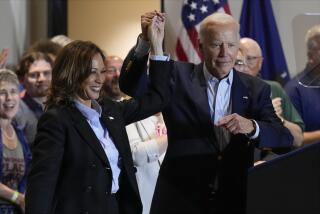Pittsburgh Shakes Off Rust, Forges Stronger Identity : Few in the halved population are still steelworkers. Many are employed in health services and high-tech industries.
- Share via
PITTSBURGH, Pa. — Rusting monoliths of the Industrial Age, the abandoned Homestead, Duquesne and McKeesport steelworks stretch for miles along the Monongahela River, one of Pittsburgh’s famous three rivers.
The sprawling mills are cold and silent proof of the Steel City’s mighty past. But they also represent Pittsburgh’s new present and its uncharted future.
For the next 20 years or longer, the obsolete U.S. Steel sites--more than 1,000 prime riverside acres of hulking mills, cathedral-size blast furnaces and vast railroad yards--will be in various stages of demolition and redevelopment.
No one knows what redevelopment will look like or what mix of industries, businesses and recreation will take root on the reclaimed sites within 13 miles of downtown.
But it is clear that Rand McNally’s 1985 choice of “Most Livable City”--where the air is clean, crime is low, the average home costs $70,000 and the metropolitan population has dropped almost 180,000 since 1980--will never again have all of its economic eggs in one industrial basket, steel or otherwise.
The Steel City died in the 1980s. Pittsburgh’s deindustrialization then was dramatic. Unemployment peaked at 14.7% in 1983, when the region’s out-of-work steelworkers became the symbol of America’s industrial decline.
The old U.S. Steel logo still rides the helmets of the Pittsburgh Steelers football team. But based on the jobs most people here hold today, Pittsburgh could be called Health Services City--or Transplant Town, in honor of the University of Pittsburgh’s medical and health center that is one of the world’s leaders in organ transplants.
Others have suggested “The Incredible Shrinking City,” in honor of its 12.8% population drop in the 1980s, when thousands of people migrated in search of jobs. The city has lost 306,926 residents since 1950 and now counts 369,879 citizens.
Economist Jake Haulk of Mellon Bank is not sure what to call Pittsburgh.
“Reborn City” or “Renewed City” come off the top of his head. The employment mix has been quickly diversified, he says, with no dominant industry in the five-county Pittsburgh area, which has a population of 2.2 million.
More than 100,000 people work in health services. The largest single employer in the region is the federal government, with 21,000.
Only 25,000 people still make their livings making steel in the region, Haulk says, and they are producing half as much steel as they did in 1979, when there were 75,000 steelworkers.
“It’s been quite a change,” Haulk says. In the 1950s, manufacturing accounted for 30% of Pittsburgh’s jobs. In the 1970s, he says, it was still 25%. But in the 1980s, “we virtually wiped it out. Half of the manufacturing jobs we had in 1979 are gone.
“We had a good, long run here. The region did well by steel. But the economic facts of life are, in an economy that keeps innovating and generating new products, you can’t have that ascendancy forever. You have to move along.”
Carnegie Mellon University is a good example of Pittsburgh’s transformation. When it was still known as Carnegie Tech, it was reknowned for metallurgy and engineering. Now it has a Robotics Institute and is a partner in the Pittsburgh Technology Center, an advanced research and technology center scheduled to open in 1993.
Pittsburgh is not a Silicon Valley, Haulk says, but 85,000 people work in 800 high-tech firms, providing technology services and computer software.
“The economy is more diversified,” he says, “but there still are pockets of extreme depression out there.”
The costs of rapid change have not been borne equally, with former towns such as Homestead, Duquesne and McKeesport suffering “what could be mortal blows,” Haulk says.
When their mills closed, the three towns found themselves not only deprived of huge tax revenues, but also faced with apparently intractable cases of Rust Belt economics--aging populations, shrinking tax bases and aggravated social problems.
Regionally, however, Haulk is sanguine about Pittsburgh’s future, predicting a slowly growing economy boosted in part by an international airport that is scheduled to open next year. And thanks to all of the praise the city has been receiving for its high livability quotient, he also foresees some slow growth in the population.
More to Read
Sign up for Essential California
The most important California stories and recommendations in your inbox every morning.
You may occasionally receive promotional content from the Los Angeles Times.












